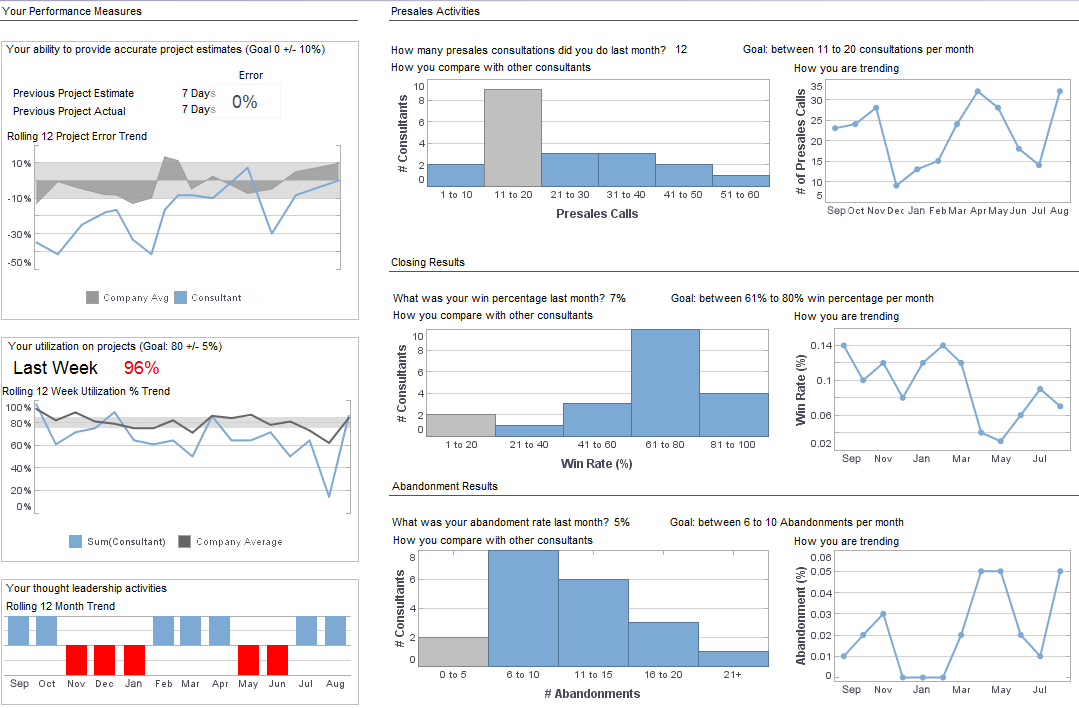Getting a Representative View of the Chain of Information
Below is the continuation of the transcript of a Webinar hosted by InetSoft on the topic of "Managing Data Complexity." The presenter is Mark Flaherty, CMO at InetSoft.
Mark Flaherty (MF): Here is a good example. I was once talking in front of an audience consisting of technology providers, actually software companies, and they said, very often what we will do is we will provide evaluation licenses of our software to prospective customers and we give them 30 days worth of customer service.
Well, as far as the sales people are concerned, they are still prospects, they are not customers because they haven’t obliged by the rule of the definition of customer which is giving the company money in exchange for the use of a product. On the other hand, as far as the customer service department was concerned, those individuals were just as customers as anybody else who shared their money with company, because they were under the licensed evaluation agreement, they were provided full customer service or full customer support.
Therefore, you have got an individual who in one context, under one definition is not a customer, but yet under another definition, that same individual is a customer. So you have got conflicting definitions, different representations, different meanings across the organization, and we end up with a lot of different underlying semantics for the same thing.
Let’s summarize. We started at the highest level. We looked at the infrastructure, the technical infrastructure, and that there is a level of complexity there. Then we looked at the layer on top of that, the application where there is some level of variation and differences across the ways that we represent the same concepts. And we looked at the actual structures that are being embedded within those applications. Then we looked at the meaning of those structures.
We see that as we continue to drill down, there is still more confusion or potential for confusion. And our objective is to look at what tech tools and techniques can we use to harness this representation of our infrastructure and of our environment, so that we can get some more global knowledge and therefore some control about the information that’s within our administrative boundaries.
And so, part of that approach is to look at modeling what we have. There are all sorts of different ways of modeling information or modeling data. Data models embody what might we called implied knowledge, but that knowledge often remains hidden inside the data when you haven’t actually sat down and kind of teased out or done some analysis of what the actual representations are. But if we continue to look at the knowledge that’s embedded within these de facto models, we can actually come up with the understanding of what’s been hidden within the data.
The Chain of Information
Let’s look at our embedded meta-data. We can look for things like business terms, the facts that are established, the relationships between business terms, conceptual domains such as states of the United States and then data element concepts that rely on those conceptual domains. And in fact, this is from the bottom up. This gives us the capability of getting the right pieces in place. We can get a representative view in different ways of, what I call, this chain of information.
In the realm of enterprise data management, the concept of a "chain of information" is crucial, serving as the backbone that supports decision-making processes, operational efficiency, and strategic planning within organizations. This chain represents the flow of data from its initial collection or creation through various stages of processing, analysis, and dissemination to ultimately inform actions and drive outcomes.
At the core of the chain of information lies data integrity and quality. For any enterprise, ensuring that data is accurate, reliable, and consistent is paramount. Without a solid foundation of trustworthy data, the entire chain of information is compromised, leading to flawed insights and misguided decisions. Therefore, enterprises invest significant resources in data governance frameworks, data quality management systems, and data validation processes to uphold the integrity of their data assets.
Once data integrity is assured, the chain of information progresses to the stage of data storage and management. This involves the organization and storage of data in databases, data lakes, or other repositories, ensuring accessibility and scalability while also adhering to security and compliance requirements. Modern enterprises often leverage cloud-based solutions and big data technologies to efficiently manage vast volumes of data across diverse sources and formats.
From storage, the chain of information extends to data processing and analysis. Here, advanced analytics techniques, such as data mining, machine learning, and predictive modeling, are employed to derive meaningful insights from raw data. By uncovering patterns, trends, and correlations, enterprises can gain valuable intelligence to optimize processes, identify opportunities, and mitigate risks. This stage often requires collaboration between data scientists, analysts, and domain experts to extract actionable insights from complex datasets.
As insights are generated, the chain of information moves towards data visualization and reporting. Visual representations, such as charts, graphs, and dashboards, play a crucial role in communicating findings to stakeholders effectively. By presenting information in a clear, concise manner, decision-makers can quickly grasp key insights and trends, facilitating informed decision-making across the organization. Interactive dashboards and self-service analytics tools further empower users to explore data and generate their own reports tailored to their specific needs.
Beyond reporting, the chain of information extends to data dissemination and sharing. Enterprises utilize various channels, such as email, intranet portals, and collaboration platforms, to distribute insights and information to relevant stakeholders. Additionally, APIs and data integrations enable seamless exchange of data with external partners, customers, and third-party applications, fostering collaboration and driving innovation. However, it's essential to implement proper access controls and data privacy measures to safeguard sensitive information and comply with regulatory requirements.
Finally, the chain of information culminates in action and decision-making. Armed with insights derived from data, decision-makers can formulate strategies, allocate resources, and implement initiatives to achieve organizational objectives. Whether it's optimizing operations, launching new products, or engaging customers, data-driven decisions empower enterprises to stay competitive in today's fast-paced business landscape.


